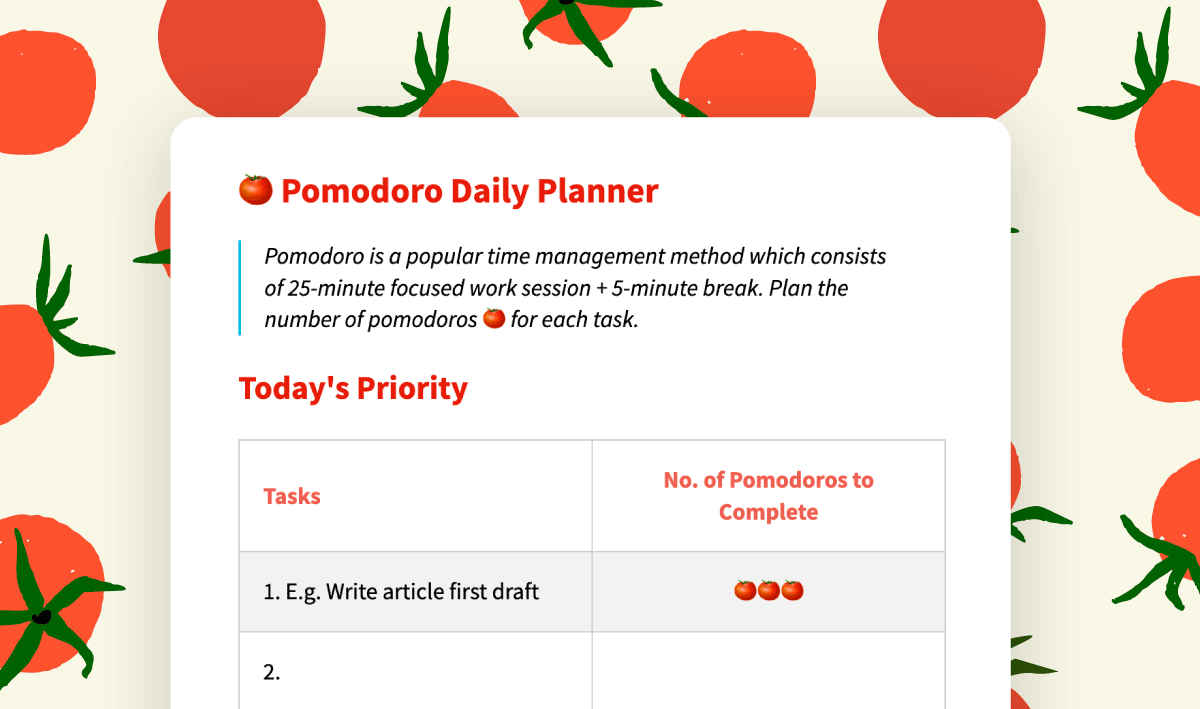Pomodoro Technique for Productivity - Why and How It Works
The Pomodoro Technique is a time management method based on 25-minute stretches of focused work broken by five-minute breaks. If you find it tough to sustain your productivity levels through your long list of to-do's, this might be the tool you need. Read on to find out more!

An almost never-ending list of tasks on your to-do list can be overwhelming and make getting things done hard. As that list grows, it starts to feel like there’s never enough time to do it all.
What if there was a time management strategy that could help you tackle your to-do list efficiently, and help you feel more productive and balanced? If you're looking for a strategy that can help you better plan your workload, overcome distractions, and check tasks off of your to-do list, read on to find out more about how the Pomodoro Technique might be best suited for you.
What is the "Pomodoro Technique"?
The "Pomodoro Technique" is a time management system that encourages people to work with the time they have on their hands in a realistic manner, rather than against it. This system of time management was developed by Francesco Cirillo in the late 1980. It uses a timer to break down work into intervals, traditionally 25 minutes in duration, that is separated by short breaks. Longer breaks, typically 15 to 30 minutes, are taken after four consecutive work intervals. Each work interval is called a pomodoro, the Italian word for tomato.

Photo by Artem Maltsev on Unsplash
This technique helps to improve focus and productivity. This allows you to, in turn, get more done in less time. It can be used for any task, from studying for an exam to writing a essay, to completing a work project or a household chore.
If you find that little distractions often derail your workday, or you find your productivity levels dipping after you work past the point of optimal productivity, or if you just really like tomatoes, the pomodoro technique might be the one for you.
How does the Pomodoro Technique help?
The almost silly use of a tomato as a stand-in for units of time does not reflect the Pomodoro Technique's effectiveness when it comes to helping people get things checked off their to-do lists. Here's what makes the method uniquely suited to boosting productivity:
1. Manage distractions and control your time
The Pomodoro Technique empowers you to take control of your own time. If a co-worker approaches you during the middle of a pomodoro, use the “inform → negotiate → schedule → call back” approach to postpone the interruption until you are ready and have completed the task at hand. Interrupting the task you have on hand to jump to another one will serve no good as it adds to your mental preoccupation and will not allow you to complete either tasks efficiently and in the best way possible.

They may seem insignificant, but small interruptions add up It isn’t just the time you lose on distractions, it also takes time and energy to refocus your attention. After switching gears, our minds can linger over the previous task for upwards of 20 minutes until regaining full concentration. Indulging the impulse to check Instagram for "just for a minute" can turn into 20 minutes of trying to refocus on the task that you need to complete.
When the distractions are internal; wanting to scroll through social media, racing thoughts, restlessness, write them down on a piece of paper and push through to the end of your pomodoro. During a break, you can take a quick look at your Instagram feed or take a quick walk around your office or home to wake your legs up.
2. Stay accountable
At the end of each 15min interval, or pomodoro, take a minute to write down what you have completed or accomplished. Keeping a record of your work will allow you to acknowledge and pat yourself on the back for your efforts.
3. Improve your planning
Recording your accomplishments will make it easier to plan effectively in the future. With time, you will be able to accurately estimate how many pomodori you will need to complete a certain type of project.
For example, a writer may notice that, on average, it takes them three "pomodori" to research a new article, one pomodoro to outline their thoughts, and two pomodori to write the article. Later, when they set goals for the amount of they need to produce in a week or a sprint, they will have a better idea of how many articles they can write based on how much time they have available.

4. Decrease mental fog and fatigue
The Pomodoro Technique requires you to intentionally schedule regular breaks. You can take the time to walk around the office or home, grab a snack, or watch a short video to rest your mind. Allowing your mind to wander for a few minutes reduces workday burnout, and when you feel good physically and mentally, you get more done.
5. Maintain motivation
As you near the end of a pomodoro and your work is almost done, you get pumped to race against the clock to finish your task before your alarm goes off. The excitement motivates you to work faster. These short bursts of motivation add up over time and will increase the amount of work you get done.

How do you use the Pomodoro Technique?
The Pomodoro Technique's biggest strength is its simplicity. The basic steps of using the Pomodoro technique are as follows:
- Get a to-do list and a timer.
- Set your timer for 25 minutes, and focus on a single task until the timer rings.
- When your session ends, mark off one pomodoro and record what you completed.
- Then enjoy a five-minute break.
- After four pomodoros, take a longer, more restorative 15-30 minute break.
As mentioned previously, this technique encourages people to work with the time they have rather than against it. If you think that this time management technique would benefit your style of working, consider Journey's Pomodoro Daily Planner to plan your time efficiently.

List out the tasks you need to complete, and the number of 25-min stretches or pomodoros you need to complete them. This way, you have a good gauge of how long you need, and you can schedule breaks. Take charge of your time with this planner today.
The Pomodoro Technique Guidelines
The 25-minute work periods are the core of the method. But this must go hand in hand with these three guidelines for you to get the most out of each interval:
Break down complex projects.
- If a task requires more than four pomodoros, it needs to be divided into smaller, actionable steps. Sticking to this rule will help ensure you make clear progress on your projects.
Small tasks can be grouped together.
- Any tasks that will take less than one Pomodoro should be combined with other simple tasks. For example, "set dental appointment," or "read a Journey blog" could go together in one session.
Once a pomodoro is set, it must ring.
- The pomodoro is a fixed unit of time that should not be broken, especially not to check incoming emails, social media notifications, or texts. Any tasks that come up should be taken note of to come back to later. A digital task manager like Journey is a great place for these, but pen and paper will do too.
- If you face an unavoidable disruption, take your five-minute break and start again. It is recommended that you keep track of these interruptions, whether they are internal or external, and reflect on how to avoid them in your next session.
The Pomodoro Technique is a great way to stay focused and motivated, and it can help you get more done in less time. It can be a valuable tool, as it guides you to work in short, timed sessions. Your pomodoros become both a unit of both time and effort. The concept of time changes from something negative or something that you don't have enough of to a positive representation of events accomplished, which is something we all need more of!
With the Pomodoro technique, you have a clear measurement of your time and your effort, allowing you to reflect and plan your days more accurately and efficiently. With practice, you'll be able to accurately assess how many pomodoros a task will take and build more consistent work habits.


